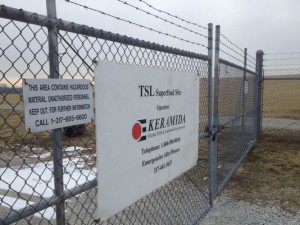 Earlier today, I was standing on top of the former Tippecanoe Sanitary Landfill, which is now a superfund site. Capped and controlled since 2000, now it looks more like a big grassy hill with intermittent monitoring wells sticking out of it. The company I am interning for, Keramida, Inc., has been the lead consultant on the cleanup and operation and maintenance of this site since it was put on the National Priorities List (NPL) in 1990. Today, we met with representatives from the USEPA, the Indiana Department of Environmental Management (IDEM), and the attorney representing the Potentially Responsible Party (PRP). The purpose of the meeting was to discuss the next steps to getting the site delisted from the NPL and cleared for recreational or commercial reuse. As I sat in the meeting, trying to absorb everything and recall what I had learned about CERCLA at Bard, I was amazed at my ability to understand the whole alphabet soup that was being thrown around: CDs, PRPs, NPL, O&M, LEL, etc.
Earlier today, I was standing on top of the former Tippecanoe Sanitary Landfill, which is now a superfund site. Capped and controlled since 2000, now it looks more like a big grassy hill with intermittent monitoring wells sticking out of it. The company I am interning for, Keramida, Inc., has been the lead consultant on the cleanup and operation and maintenance of this site since it was put on the National Priorities List (NPL) in 1990. Today, we met with representatives from the USEPA, the Indiana Department of Environmental Management (IDEM), and the attorney representing the Potentially Responsible Party (PRP). The purpose of the meeting was to discuss the next steps to getting the site delisted from the NPL and cleared for recreational or commercial reuse. As I sat in the meeting, trying to absorb everything and recall what I had learned about CERCLA at Bard, I was amazed at my ability to understand the whole alphabet soup that was being thrown around: CDs, PRPs, NPL, O&M, LEL, etc.
I started at Keramida 4 weeks ago, and I have left every day of work feeling confident and knowing that Bard had  prepared me perfectly for that day’s work. Keramida, Inc. is an environmental engineering consulting firm specializing in EHS and sustainability services. Founded in 1988 by Vicky Keramida, Keramida, Inc. has been on the cutting edge of technical assistance for environmental regulations since the beginning. This has led to a strong institutional knowledge of brownfield redevelopment and superfund cleanup that has helped augment my in-class learning and understand how these laws are applied in real life.
prepared me perfectly for that day’s work. Keramida, Inc. is an environmental engineering consulting firm specializing in EHS and sustainability services. Founded in 1988 by Vicky Keramida, Keramida, Inc. has been on the cutting edge of technical assistance for environmental regulations since the beginning. This has led to a strong institutional knowledge of brownfield redevelopment and superfund cleanup that has helped augment my in-class learning and understand how these laws are applied in real life.
Every day that I go to work, I am amazed at how well this internship fits my interests as well as my education. The main project that I am working on is an area wide planning project funded by a grant from the USEPA’s brownfield program. This grant was awarded to The City of Indianapolis to work through a structured planning process to determine the best uses for a 19-acre brownfield site in urban Indianapolis. As the lead consultants on this project, my colleague and I are in charge of working through the EPA’s area wide planning process, which includes tasks such as community engagement and outreach, market analysis, review of challenges to brownfield redevelopment, and neighborhood mapping. I am lucky enough to have an incredible supervisor who I learn from every day. As we meet with different stakeholders in the community, I learn from the questions she asks and the way that she controls the situation. Afterwards, we learn from each other as we debrief on each meeting.
One of the key lessons that I have learned about community planning is the importance of being aware of the world of history that exists in a neighborhood and between stakeholders. I have been told by many community organizers and government representatives that our neighborhood of focus has been “planned to death”, and I think that to a certain extent, this is true. What excites me is to be a key part of the team that could actually make a real difference. The 19-acre brownfield that we are trying to redevelop is an incredible opportunity for many reasons. First, it has already been cleaned, and all of the buildings have been demolished. Second, The City owns the land, and third, The City is extremely excited to use it in a way that improves the economic, social, and environmental health of the community.
I am incredibly lucky to have found this position at KERAMIDA, Inc., and I can’t wait to see what the future has in store.
